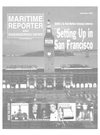
Page 12: of Maritime Reporter Magazine (September 2003)
Read this page in Pdf, Flash or Html5 edition of September 2003 Maritime Reporter Magazine
Government Update
Careful, Your Species May Be Non-Indigenous
By Dennis L. Bryant, senior maritime counsel, Holland & Knight
Dangers posed by movement of species from one part of the world to another where they are uncommon (non- indigenous) have been recognized since the black death (bubonic plague) arrived in western Europe from central Asia in the I300's, killing up to one-third of
Europe's population. Modern medicine has been able to address most disease outbreaks, as evidenced by our recent experience with SARS (severe acute respiratory syndrome). The environ- ment has coped less successfully.
Since man began traveling long dis- tances in relatively short time, plants and animals have also made the voyage.
Some have been brought intentionally, as when European domestic animals and crops were transported to America and
Australia for farming. Others, such as rats, were brought unintentionally.
Regardless of why these non-indigenous species have reached a new environ- ment. the result may be disastrous for the native species.
Modern large ships present a particular environmental problem in this regard, as they are both fast and carry large vol- umes of water when in ballast. This bal- last water is commonly taken onboard when the vessel unloads its cargo in one port and discharged into local waters when the vessel is preparing to load a new cargo. As the distance between the two ports increases, the chances increase that plant and animal life in the ballast water will not be native to the waters where the ballast is discharged.
Generally, the local waters where the ballast is discharged will be sufficiently different from the waters where the bal- last was loaded that the plant and ani- mals contained therein fail to survive.
But, when those few non-indigenous species that do survive find a foothold, an ecological disaster is possible.
The Origin of the Species
It is believed that zebra mussels were transported in ballast water by ships sailing from ports in the Black Sea to the
Great Lakes of North America in the early 1980s. Infestations of zebra mus- sels were not noticed until about 1988, when they started clogging water intake pipes. Zebra mussels are such success- ful breeders and prodigious eaters and have so few natural enemies in their new environment that they tend to crowd out native species. Damages resulting from the spread of zebra mussels in North
American waters and resultant control expenses are estimated to cost $500 mil- lion annually.
While zebra mussels are the best known of the non-indigenous aquatic species, they are by no means alone.
The European Green Crab, now found on both coasts of North America, is a voracious predator that feeds on bivalve mollusks and small crustaceans. The
Chinese Mitten Crab (which may have been introduced illegally as a food source) has spread through the San
Francisco Bay region, burrowing into and weakening dikes and levees, as well
Dennis L. Bryant, Senior Maritime
Counsel at the law firm of Holland & Knight, Washington, D.C., is a contributing editor of MR/EN. as competing with local species. A recent study indicates that between six and 25 percent of the different species of plants and animals found in coastal waters of California may be non-indige- nous. For many of these, it is too early to determine whether they will have deleterious impacts on the local bios-
INTRODUCING SAAB TANKRADAR' STaR:
Well, it looks like another 25 years in the lead.
Circle 254 on Reader Service Card ftgs •
Take a closer look inside our new tank gauging system, Saab
TankRadar® STaR. It will bring intelligence and integration to your tank monitoring—offering a superior range of functions.
The new STaR system features a 3-in-1 solution that integrates Level Gauging, High Level and Overfill Alarm systems in a single unit—designed as independent, intrinsically safe, measuring channels. As a result, it's easy to install, maintain and operate.
STaR takes advantage of a new sensor technology for safer and more reliable loading and discharge. And it's future-proof—the integration capabilities of STaR ensure compatibility with new and emerging software.
STaR is the latest proof of our technology leadership.
No wonder that nearly 60% of all the new tank gauging installations in the marine market are designed and delivered by us.
ETiTiTH ROSIMQUNT
Marine
Phone: +46 31 3370 000 • E-mail: [email protected]
Web: www.saabrosemount.com
Maritime Reporter & Engineering News

 11
11

 13
13
